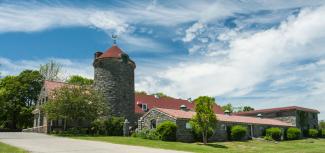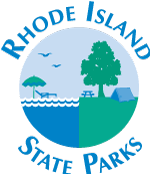Colt State Park History (1968)

Colt State Park’s more than 464 acres of lawns, stone walls, and curving drives along one of the state’s most spectacular shorelines stand in contrast to one of Rhode Island’s charming, compact, historic seaports, the Town of Bristol. On July 4th, every year since 1785, the town of Bristol has put on America’s team colors and hosted a national celebration that’s actually older than the ratification of the U.S. Constitution (1790). Fittingly, it was Rhode Island that closed that exercise, and the nation began.
The comparison, or rather a contrast, of the town and the park couldn’t be stronger. Bristol was one of the few Rhode Island towns actually laid out in New England fashion, with a town common and a grid pattern of streets and lanes. Mostly mercifully intact from the time period of Ratification, the town boasts long parallel streets of closely packed Federal and Greek Revival architecture, a fitting theatrical backdrop to the annual pageant of flags, floats, drums, and bugles. Colt State Park, by contrast, is sprawling, curvilinear, nearly without buildings, its copses and clusters of trees mirroring the off-shore bobbing of masts of sailboats. While the town is dense and urban, the park is wide open. They are both beautiful and memorable.
The park and the town are linked by history. Samuel P. Colt, who built the showcase farm, was a grandson of the famous DeWolf family of Bristol. The DeWolfs developed Bristol into a thriving port in the late 18th and early 19th century. They defiantly and successfully carried on the Slave Trade after it was outlawed by the State of Rhode Island. Powerful, politically, they were able to get their own candidate appointed as U.S. Customs Collector and escaped the law…at least for a while. They had plantations in Cuba and fleets of ships, built palatial mansions on Hope Street and managed to drag most of the other leading families into their schemes. When their empire finally imploded in 1825, they also dragged the whole town into bankruptcy.
Twenty-five years and a generation later, the Colt family, grandsons of George DeWolf and great-grandsons of Senator James DeWolf, moved back into town and began a new chapter in the story of ‘The Great Folks,’ as the DeWolfs and Colts were known by the local population. While LeBaron Colt ultimately became a U.S. Senator, it was his brother, Samuel Pomeroy Colt, who rebuilt the family fortune. Also a lawyer, like his brother, but less successful in politics, Samuel P. Colt made his fortune in banking and manufacturing. Not only did he manage to restore his family’s money, but he erased a good deal of the blot on the family crest caused by the fall of the DeWolf family and the ruin of the town.
Operating in an age of aggressive capital, from 1875 to 1915, Colt assembled a collection of local banks leading to the emergence of the Industrial Trust Company, the forerunner of Fleet Bank, which became the largest financial institution in the State of Rhode Island. He also knitted together nascent rubber companies in Bristol, Providence, and Woonsocket, which evolved into the United States Rubber Company (Uniroyal). He served as president of the Industrial National Trust until 1908 and U.S. Rubber until 1918. He supported local civic projects like the Colt Memorial High School as a way of ingratiating himself with the town, and he opened his private estate, the Colt Farm, to be enjoyed by the public.
Beginning in 1905, Colt began to assemble the parcels of land that would become his farm on Poppasquash Neck from lands owned by old Bristol families. These were the farms of the Chase, Church, and Van Wickle families.
Colt Farm, now Colt State Park, became a showcase of wealth. The entrance to the property alone spoke of the tone and ambition of the owner. A pair of bronze bulls anchors the approach. Throughout the drive to the main house and its complex of barns, a party casino, and stables, Colt dotted the landscape with examples of European sculpture and statuary of mythical Greek gods and goddesses. This display of the human form prompted one of Colt’s relatives to call the drive to the casino/party pavilion “Wall Street,” an avenue of the “bulls and the bares!” Colt prided himself on operating the farm to breed prize Jersey cattle. The magnificent cow barn is one of the surviving structures in the park.
As local town histories note, no expense was spared on Colt’s prized herd. “There was one employee for each cow. The cows' horns were polished, and their tails were washed daily. When in their stanchions, the cows always had a thick bed of fresh straw. Cork and rubber covered the concrete floor where the cows stood. The spotless, comfortable barn was even heated in the winter.”
“Each summer, Colonel Colt’s finest Jersey cows, and his prize Berkshire sows, were transported in specially padded railroad cars to state and county fairs throughout the East. The show season ended in September with the annual Eastern States Exposition in Springfield, Massachusetts. Every show season brought more trophies and ribbons to the elegant trophy room. In one season alone, the Berkshire sows won 125 ribbons.”
“Tractors were not used on the farm; Colt preferred to see Percheron draft horses working in the fields. During the summer, hay was carried in horse-drawn wagons from the fields to the hayloft, where it was stored as winter food. Colonel Colt, who often visited the farm from his home in Bristol on Hope Street, valued the Percheron horses as much as he did his Jersey herd. If he saw that the horses were sweating from hauling wagon loads of hay, Colt ordered the haying stop for the day. In the winter, the same horses were harnessed to snow plows for clearing the roads of the farm. Colt insisted that the horses wear blankets for protection from the cold winter wind that blew off Narragansett Bay and across the exposed fields and roads of the farm. The Percherons were housed in a large wooden barn that still stands on a hill across the salt marsh from the stone barn.”
Colt’s desire to share hospitality with the public and a philosophical forerunner to using the site as a state park was engraved in marble at the main entrance: ‘Colt Farm: Private Property, Public Welcome.’ According to one observer, “ On pleasant days, families walked from the town of Bristol to picnic in the fields, dig clams and quahogs in the Mill."
Workers in white guided people through the magnificent stone barn, pointing out prize cows and offering glasses of fresh milk to the visitors. The mangers were scrubbed after each feeding, and the white-tile ceiling was kept mirror clean so that the entire herd of cows in the stanchions could be seen reflected in the ceiling. A visitor to the farm once wrote, ‘If I were the biggest liar in the world, I could not exaggerate the magnitude and the wonders of Colt Farm.”
Besides the general public’s use of the property for picnics, Colt oversaw the obsequies of Rhode Island social life at the farm’s casino. Part business, part politics, part good life socializing, in the summertime, trains from Providence to Bristol brought guests who were met at the town station by a car or carriage and conveyed to the farm.
Samuel P. Colt died in 1921. Disputes about his will, clouded by disagreements among family members, stalled attempts by the State to acquire the property by the Metropolitan Park Commission in 1935. It wasn’t until 1965, using Green Acres funds, that the state bought the farm for use as a park. In the meantime, throughout the intervening years, the estate was managed by the Industrial Trust Company. Governor John H. Chafee dedicated the park in 1968. Today, a statue of Chafee overlooks the landscape of an open-air Chapel by the Sea, ten playing fields, six picnic groves, restrooms, a public boat ramp, and four miles of walking, jogging, and bicycle trails.
The East Bay Bikeway, connecting Colt to a string of other state parks from East Providence through Barrington and on to Bristol center, will soon be linked to the John H. Chafee Blackstone River Valley National Heritage Corridor with its Blackstone River State Park and Bikeway route stretching all the way to the Woonsocket boundary with Massachusetts, a scenic parkway of over thirty miles.
